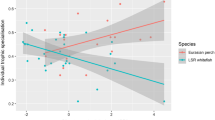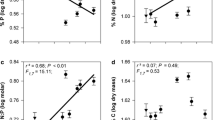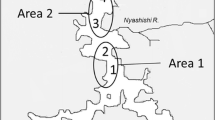Abstract
Individual behavior drives population-level patterns, yet few studies have integrated how intraspecific niche partitioning influences energy pathways that support consumer production across multiple ecosystem states. We used stable isotope analyses to assess the individual foraging behavior of a dominant consumer, yellow perch (Perca flavescens), in a single lake (Oneida Lake, NY) under both eutrophic (1960s) and mesotrophic (2000s) conditions and at different yellow perch densities. We then integrated this data with intensive population surveys to assess how variation in foraging behavior between individuals and lake trophic status interacts to drive energy pathways supporting consumer production. Stable isotope analyses highlight that individual yellow perch varied greatly in their reliance on benthic and pelagic energy pathways even within a given year. At the population-level, benthic reliance increased from 2 to 20% under eutrophic conditions to 30–70% under mesotrophic conditions. At low densities, individual fish primarily selected inshore habitats and were reliant on benthic carbon, increasing population-level reliance on benthic carbon. This pattern was present during both trophic states, but was more pronounced during mesotrophic conditions. Our results highlight that variation in foraging behavior between individuals can affect the integration of benthic and pelagic energy pathways at the population-level, and that this integration is dependent on ecosystem state and consumer population density. We propose that models that incorporate variation between individual consumers across multiple habitats can more accurately represent energy flows within ecosystems.







Similar content being viewed by others
References
Agrawal AA, Ackerly DD, Adler F, Arnold AE, Càceres C, Doak DF, Post CE, Hudson PJ, Maron J, Mooney KA, Power M, Schemske D, Stachowicz J, Strauss S, Turner MG, Werner E. 2007. Filling key gaps in population and community ecology. Front Ecol Environ 5:145–52.
Anderson MJ. 2001. A new method for non-parametric multivariate analysis of variance. Aust Ecol 25:32–46.
Araújo MS, Guimaraes PR Jr, Svanbäck R, Pinheiro A, Guimaraes P, dos Reis SF, Bolnick DI. 2008. Network analysis reveals contrasting effects of intraspecific competition on individual versus population diets. Ecology 89:1981–93.
Bolnick DI, Svanbäck R, Fordyce JA, Yang LH, Davis JM, Hulsey CD, Forister ML. 2003. The ecology of individuals: incidence and implications of individual specialization. Am Nat 161:1–28.
Bowman, J.E. 2005. The use of stable isotopes to elucidate feeding relationships in key fish species in the Bay of Quinte and Oneida Lake. MS Thesis. University of Waterloo, Waterloo, Ontario, Canada.
Burnham KP, Anderson DR. 2002. Model selection and multimodel inference: a practical information-theoretic approach. 2nd edn. New York: Springer.
Carpenter SR, Turner MG. 2001. Hare and tortoises: interactions of fast and slow variables in ecosystems. Ecosystems 3:495–7.
Clady MD. 1976. Changes in the abundance of inshore fishes in Oneida Lake, 1916 to 1970. N Y Fish Game J 23:73–81.
Elton CS. 1927. Animal ecology. London: Sidgwick and Jackson.
Fitzgerald DG, Forney JL, Rudstam LG, Irwin BJ, VanDeValk AJ. 2006. Gizzard shad put a freeze on winter mortality of age-0 yellow perch but not white perch. Ecol Appl 16:1487–501.
Fitzgerald DG, Zhu B, Mills EL, Rudstam LG, Hoskins SB, Haddad DE, Burtch NR, Coleman JT, Crabtree DL. In press. Dynamics of aquatic vegetation in Oneida Lake, 1915–2005: a response to ecosystem change. In: Rudstam LG, Mills EL, Jackson JR, Stewart DJ, Eds. Oneida Lake: long-term dynamics of a managed ecosystem and its fisheries. Bethesda, MD: American Fisheries Society.
Forbes SA. 1887. The lake as a microcosm. Peoria: Bull Sci Assoc. pp 77–87.
Forney JL. 1974. Interactions between yellow perch abundance, walleye predation, and survival of alternative prey in Oneida Lake, NY. Trans Am Fish Soc 103:15–24.
Hall SR, Rudstam LG. 1999. Habitat use and recruitment: a comparison of long-term recruitment patterns among fish species in a shallow eutrophic lake, Oneida Lake, NY, USA. Hydrobiologia 408:101–13.
Higgins SN, Vander Zanden MJ. 2010. What a difference a species makes: a meta-analysis of dreissenid mussel impacts of freshwater ecosystems. Ecol Monogr 80:179–96.
Hirsch PE, Eklöv P, Svanbäck R. 2013. Indirect trophic interactions with an invasive species affect phenotypic divergence in a top consumer. Oecologia 172:245–56.
Irwin BJ, Rudstam LG, Jackson JR, VanDeValk AJ, Forney JL, Fitzgerald DG. 2009. Depensatory mortality, density-dependent growth, and delayed compensation: disentangling the interplay of mortality, growth, and density during early life stages of yellow perch. Trans Am Fish Soc 138:99–110.
Jones AW, Post DM. 2013. Consumer interaction strength may limit diversifying effect of intraspecific competition: A test in alewife (Alosa pseudoharengus). American Naturalist 181:815–26.
Lindeman RL. 1942. The trophic-dynamic aspect of ecology. Ecology 23:399–418.
Martínez del Rio CM, Sabat P, Anderson-Sprecher R, Gonzalez SP. 2009. Dietary and isotopic specialization: the isotopic niche of three Cinclodes ovenbirds. Oecologia 161:149–59.
Mayer CM, VanDeValk AJ, Forney JL, Rudstam LG, Mills EL. 2000. Response of yellow perch (Perca flavescens) in Oneida Lake, New York, to the establishment of zebra mussels (Dreissena polymorpha). Can J Fish Aquat Sci 57:742–54.
Mayer CM, Zhu B, Cecala R. In press. The zebra mussel invasion of Oneida Lake: benthification of a eutrophic lake. In: Rudstam LG, Mills EL, Jackson JR, Stewart DJ, Eds. Oneida Lake: long-term dynamics of a managed ecosystem and its fisheries. Bethesda, MD: American Fisheries Society.
Mills EL, Forney JL. 1981. Energetics, food-consumption, and growth of young yellow perch in Oneida Lake, New York. Trans Am Fish Soc 110:479–88.
Oksanen J, Blanchet FG, Kindt R, Legendre P, Minchin P, O’hara RD, Simpson GL, Solymos P, Stevens MH, Wagner H. 2003. vegan: Community Ecology Package. R package version 2.0–10. http://CRAN.R-project.org/package=vegan.
Pace ML, Cole JJ, Carpenter SR, Kitchell JF, Hodgson JR, Van de Bogert MC, Bade DL, Kritzberg ES, Bastviken D. 2004. Whole-lake carbon-13 additions reveal terrestrial support of aquatic food webs. Nature 427:240–3.
Pinheiro J, Bates D, Debroy S, Sarkar, D, R Core Team. 2015. nlm: Linear and Nonlinear Mixed Effects Models. R package version 3.1–120. http://CRAN.R-project.org/package=nlme.
Plummer M. 2003. JAGS: a program for analyses of Bayesian graphic models using Gibbs sampling. In: Hornik K, Leisch F, Zeileis A, Eds. Proceedings of the 3rd International Workshop on Distributed Statistical Computing, March 20–22. Vienna: Austria.
Post JR, Johannes MRS, McQueen DJ. 1997. Evidence of density-dependent cohort splitting in age-0 yellow perch (Perca flavescens): potential behavioural mechanisms and population-level consequences. Can J Fish Aquat Sci 54:867–75.
Post DM. 2002. Using stable isotopes to estimate trophic position: models, methods, and assumptions. Ecology 83:703–18.
Prout MW, Mills EL, Forney JF. 1990. Diet, growth, and potential competitive interactions between age-0 white perch and yellow perch in Oneida Lake, New York. Trans Am Fish Soc 119:966–75.
Quevedo M, Svanbäck R, Eklöv P. 2009. Intrapopulation niche partitioning in a generalist predator limits food web connectivity. Ecology 90:2263–74.
R Development Core Team. 2013. R: a language and environment for statistical computing. R Foundation for Statistical Computing, Vienna, Austria. http://www.R-project.org/.
Rennie MD, Ozersky T, Evans DO. 2012. Effect of formalin preservation on invertebrate stable isotope values of decadal time scales. Can J Zool 90:1320–7.
Roseman EF, Mills EL, Forney JL, Rudstam LG. 1996. Evaluation of competitive interactions between age-0 yellow perch (Perca flavescens) and gizzard shad (Dorosoma cepedianum) in Oneida Lake, New York. Can J Fish Aquat Sci 53:865–74.
Rudstam LG. 2015. Limnological data and depth profile from Oneida Lake, New York, 1975–2014. Knowledge Network for Biocomplexity. https://knb.ecoinformatics.org/#view/kgordon.35.63.
Rudstam LG, Jackson JR. 2012. Yellow perch abundance and length at age in Oneida Lake, NY (1957–2011). Knowledge Network for Biocomplexity. http://knb.ecoinformatics.org/knb/metacat/cbfs.127.12/knb.
Sarakinos HC, Johnson ML, Vander Zanden MJ. 2002. A synthesis of tissue-preservation effects on carbon and nitrogen isotope signatures. Can J Zool 80:381–7.
Scheffer M, Hosper SH, Meijer ML, Moss B, Jeppesen E. 1993. Alternative equilibria in shallow lakes. Trends Ecol Evol 8:275–9.
Schindler DE, Hilborn R, Chasco B, Boatright CP, Quinn TP, Rogers LA, Webster MS. 2010. Population diversity and the portfolio effect in an exploited species. Nature 465:609–12.
Schoener TW. 1974. Resource partitioning in ecological communities. Science 185:27–39.
Solomon CT, Carpenter SR, Clayton MK, Cole JJ, Coloso JJ, Pace ML, Vander Zanden MJ, Weidel BC. 2011. Terrestrial, benthic, and pelagic resource use in lakes: results from a three-isotope Bayesian mixing model. Ecology 92:1115–25.
Su Y, Yajima M. 2015. R2jags: A Package for Running ‘JAGS’ from R. R package version ≥ 2.14. http://CRAN.R-project.org/package~R2jags.
Svanbäck R, Persson L. 2009. Population density fluctuations change the selection gradient in Eurasian perch. Am Nat 173:507–16.
Vadeboncoeur Y, Peterson G, Vander Zanden MJ, Kalff J. 2008. Benthic algal production across lake size gradients: interactions among morphometry, nutrients, and light. Ecology 89:2542–52.
Vander Zanden MJ, Vadeboncoeur Y. 2002. Fishes as integrators of benthic and pelagic food webs in lakes. Ecology 83:2152–61.
Vander Zanden MJ, Vadeboncoeur Y, Chandra S. 2011. Fish reliance on littoral-benthic resources and the distribution of primary production in lakes. Ecosystems 14:894–903.
Weidel B, Carpenter S, Cole J, Hodgson J, Kitchell J, Pace M, Solomon C. 2008. Carbon sources supporting fish growth in a north temperate lake. Aquat Sci 70:446–58.
Wilkinson GM, Carpenter SR, Cole JJ, Pace ML, Yang C. 2013. Terrestrial support of pelagic consumers: patterns and variability revealed by a multilake study. Freshw Biol 58:2037–49.
Zhu B, Fitzgerald DG, Mayer CM, Rudstam LG, Mills EL. 2006. Alteration of ecosystem function by zebra mussels in Oneida Lake: impacts on submerged macrophytes. Ecosystems 9:1017–28.
Acknowledgments
We thank the staff and students of the Cornell Biological Field Station for assisting with field and laboratory work. The manuscript was improved by suggestions from Sarah Collins, Christopher Dalton, and Derek West. Kyle Herreman produced the map. This study was funded by the New York State Department of Environmental Conservation through Federal Aid in Sport Fish Restoration Project F-48-R to the Cornell Warmwater Fisheries Unit and a Cornell University Biogeochemistry and Environmental Biocomplexity IGERT program small grant awarded to W. Fetzer. All sampling was conducted under Cornell University IACUC protocol #2006-0088.
Author information
Authors and Affiliations
Corresponding author
Additional information
Author contributions
William W. Fetzer, James R. Jackson, and Lars G. Rudstam conceived of or designed study. William W. Fetzer, Margaret M. Luebs, James R. Jackson, and Lars G. Rudstam performed research. William W. Fetzer, and Margaret M. Luebs analyzed data. William W. Fetzer wrote the paper.
Electronic supplementary material
Below is the link to the electronic supplementary material.
Rights and permissions
About this article
Cite this article
Fetzer, W.W., Luebs, M.M., Jackson, J.R. et al. Intraspecific Niche Partitioning and Ecosystem State Drive Carbon Pathways Supporting Lake Food Webs. Ecosystems 18, 1440–1454 (2015). https://doi.org/10.1007/s10021-015-9910-9
Received:
Accepted:
Published:
Issue Date:
DOI: https://doi.org/10.1007/s10021-015-9910-9




